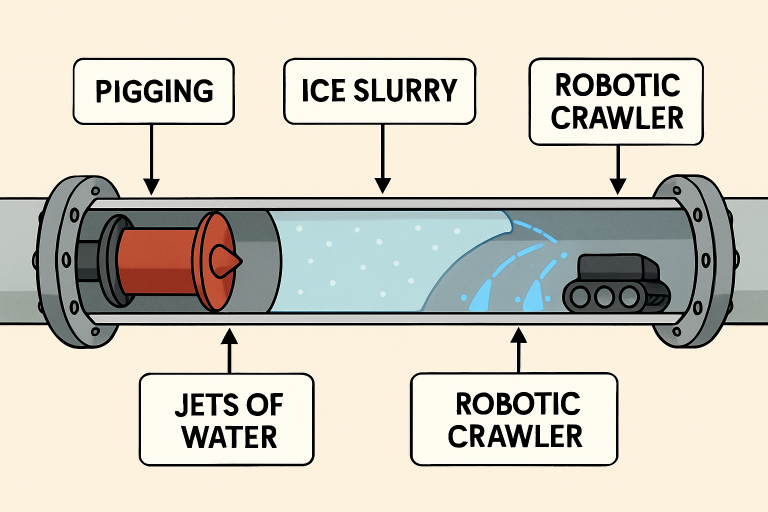Introduction
Maintaining pipelines is essential for safety, efficiency, and system longevity across industries such as oil and gas, water distribution, and manufacturing. As these pipelines accumulate scale, debris, and contaminants over time, their operational integrity can become compromised, leading to inefficiencies and potential hazards. Today, advanced cleaning technologies are transforming pipeline maintenance. Understanding the types and uses of pipe cleaning pigs for maintenance is vital, as modern solutions harness smart technologies to maximize performance while minimizing downtime and environmental impact.
Pipeline cleaning strategies have evolved far beyond basic mechanical scouring. From robotics to real-time monitoring, the range of available solutions can meet the needs of complex pipeline infrastructure. Integrating these new tools and techniques not only curbs unexpected failures and costly repairs but also supports compliance with tightening industry standards.
Smart Pigging: Intelligent Inspection and Cleaning
Traditional pigging methods push cleaning devices called pigs through pipelines to sweep out debris and deposits. With smart pigging, advanced sensors and data loggers are integrated into these devices, making it possible to collect crucial operational data and structural insights as they travel. Smart pigs not only mechanically clean, but also scan for corrosion, cracks, and wall loss, allowing for scheduled, data-driven maintenance before issues escalate.
This intelligent technology empowers operators to build a complete picture of pipeline health, resulting in more targeted repairs and extended asset life. Industries have turned to smart pigging for its cost-effectiveness, comprehensive inspection capabilities, and role in reducing environmental and safety risks inherent to pipeline operations. Details on how pigging technology is evolving can be found in resources such as Corrosionpedia’s industry insights.
Ice Pigging: A Cool Approach to Cleaning
Ice pigging uses a slurry of ice as both a cleaning agent and a carrier medium, which is pumped through pipelines to scour the interior walls. Unique to ice pigging is its ability to traverse complex pipeline layouts and variable diameters, removing biofilms, mineral deposits, and scaling with minimal risk of abrasion or system disruption.
Once the cleaning process is complete, the ice simply melts, resulting in a residue-free pipeline that requires little post-operation flushing. This method consumes less water and energy compared to conventional techniques, making it an environmentally preferable option. Water utilities, for example, have found ice pigging invaluable for sensitive systems and environmentally regulated environments.
Hydro-Jetting: High-Pressure Precision
Hydro-jetting involves directing high-pressure streams of water into pipelines to break up and remove obstructions such as grease, roots, and accumulated scale. This method is fast, non-invasive, and highly effective at restoring pipeline capacity. Notably, hydro-jetting employs only water, eliminating chemical hazards and lowering the environmental footprint of the cleaning process. It is suitable for a wide range of pipeline materials and diameters, making it a versatile choice across sectors.
Chemical Cleaning: Dissolving Deposits Effectively
For deposits resistant to physical cleaning, chemical cleaning offers a targeted solution. Specialized chemical agents are introduced into the pipeline to dissolve mineral scales, corrosion products, and organic build-up. This method can reach areas inaccessible to mechanical pigs or robotics, including bends and valves, ensuring comprehensive cleaning even in the most complex systems.
Chemical cleaning formulations are chosen based on the specific nature of the deposits and pipeline material, which helps optimize cleaning efficiency without causing damage. Chemical circulation is carefully controlled and monitored to guarantee complete removal and environmental safety. For deeper insights into industry best practices and regulatory perspectives, the U.S. Environmental Protection Agency’s (EPA) corrosion control guidelines offer valuable information.
Robotic Systems: Automation in Maintenance
The emergence of advanced robotics has revolutionized pipeline inspection and cleaning. Robotic crawlers equipped with cameras, sensors, and cleaning attachments maneuver inside pipelines, performing thorough inspections and maintenance autonomously. Robotic systems excel in hard-to-reach or hazardous environments where manual intervention would be dangerous or impossible, drastically reducing occupational risks.
These robotic units supply real-time visuals and diagnostic data for early leak detection and anomaly tracking, streamlining the decision-making processes for repairs and integrity management. This means maintenance operations are not only safer, but also more consistent, frequent, and reliable.
Real-Time Monitoring: Proactive Maintenance Strategies
Continuous monitoring of pipeline systems, using integrated sensor networks to measure vital parameters like flow rate, pressure, and temperature, allows operators to detect irregularities in real-time and prevent costly emergency repairs. This data-centric approach ensures reliability and safety in pipeline operations, as digital transformation shapes infrastructure management. Innovations in pipeline cleaning, such as smart pigging and robotics, improve safety, resource management, and system longevity. As industries strive for efficiency and environmental compliance, adopting leading-edge maintenance practices is essential for long-term success.




